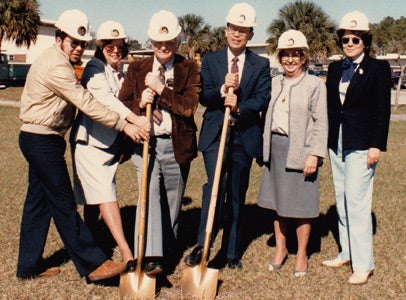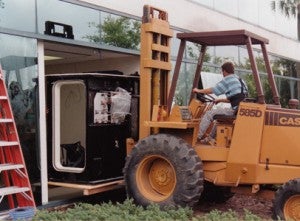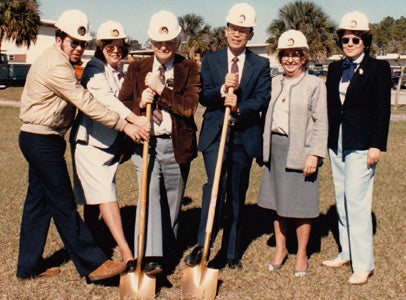The Institute for Simulation & Training (IST) turns 30 this year.
The multidisciplinary research institute recently kicked off its months-long observance of three decades of commitment to achievement in simulation and training with a cake cutting at its Partnership II building headquarters in Central Florida Research Park.

Seeds for the idea of a simulation institute were planted in the mid-1960s, about the time the Naval Training Equipment Center (NTEC) and Army Project Manager for Training Devices (PM TRADE) relocated to Orlando. Nearly 20 years went by before the idea began to sprout.
UCF was still a fledgling Florida Technological University (FTU) back then. Throughout the ’70s, FTU faculty and students provided academic support and contract research for the two defense training centers, but an organizational structure was lacking. That changed in August, 1982, with a proposal that would lead to creation of the Institute for Simulation & Training.
From humble beginnings in a double-wide style temporary headquarters near the southern, industrial side of campus, IST grew steadily along with the central Florida simulation industry. In two short years the institute left the portable behind and relocated to the Research Pavilion, UCF’s centerpiece building in the nearby research park.
The move proved auspicious, for now IST was right next door to its two defense partners – and one of them, the Army, had two tank simulators to spare.
The simulators were part of a cutting edge networking technology that was drawing a lot of attention – and frequent requests for demonstrations. The Army was continually under pressure to drop everything to get ready for the next bus load of VIPs. A deal with IST would allow the Army to “get back to work.”

The institute acquired the loan of the tanks and responsibility for demonstrating the new SIMNET technology. This was IST’s first real opportunity for exposure to a ready made audience of defense brass and political leaders eager for a photo op and a chance to know more about the emerging science of simulation.
In its five years at the Research Pavilion, IST led breakthroughs in simulator networking and computer-generated forces used for war games. A move to its own building was soon followed by Senate Armed Services Committee Chair, Senator Sam Nunn’s declaration that Central Florida was the nation’s hub of simulation technology and UCF America’s leading simulation university.
Florida Governor Lawton Chiles added more honors in 1997, proclaiming the Central Florida Research Park “the National Center for Simulation.” In ensuing years the research park and surrounding area grew to become arguably the nation’s highest concentration of companies and agencies dedicated to simulation and training-related research and development.
Although, as records show, IST from the beginning worked diligently to develop and maintain partnerships, as the ’90s drew to a close those efforts began to take substance in concrete and steel. The institute began this “brick and mortar” phase first by building behind the UCF fire station a modest training building for crisis managers, then by coordinating the renovation of a vacant research park building destined to become known as the Army’s SFC Paul Ray Smith Simulation & Technology Training Center. Soon thereafter, IST tackled construction of the five-story Partnership II building, followed a few years later by Partnership III, both also in the research park. As the names imply, the buildings are occupied by a mixture of IST, UCF and defense agency tenants.
Simulation and training in the 21st Century took on dimensions hardly imagined – even in the ’80s. The discipline’s horizons stretched far beyond earlier foundations in mechanical engineering and computer science to encompass psychology, cognitive science, robotics, human factors engineering, mathematical analysis, philosophy, learning theory, culture studies, to name a few.
With all these multidisciplinary underpinnings, modeling and simulation became a discipline worthy of its own advanced levels of academic study. IST led the push for multidisciplinary master’s and doctoral simulation degrees and the program accepted its first students in 2002.
The diversity of the industry is well-represented by the many disciplines making up the institute’s more than 200-strong complement of staff, research faculty and part-time student interns.
IST’s clientele, a far cry from the one-source initial partnership with the Army, is similarly diverse. Department of Defense contracts still account for a large portion of the institute’s contract and grant support, but clients range from businesses and agencies seeking more effective ways to train (Google, Johnson & Johnson, US Department of Education and Federal Aviation Administration, to name a few) to health care providers with similar training goals, to museums and science centers looking to simulation to enhance their exhibits’ learning value.
